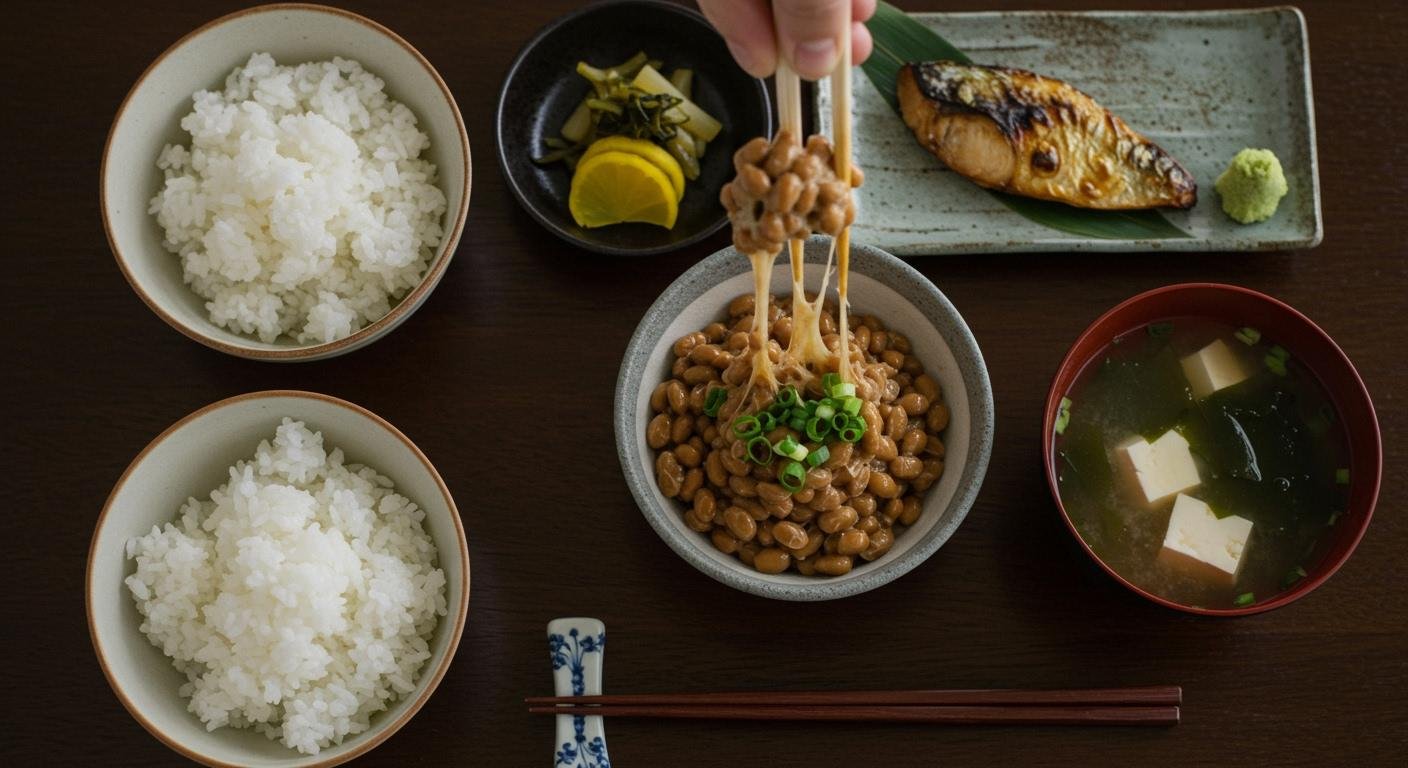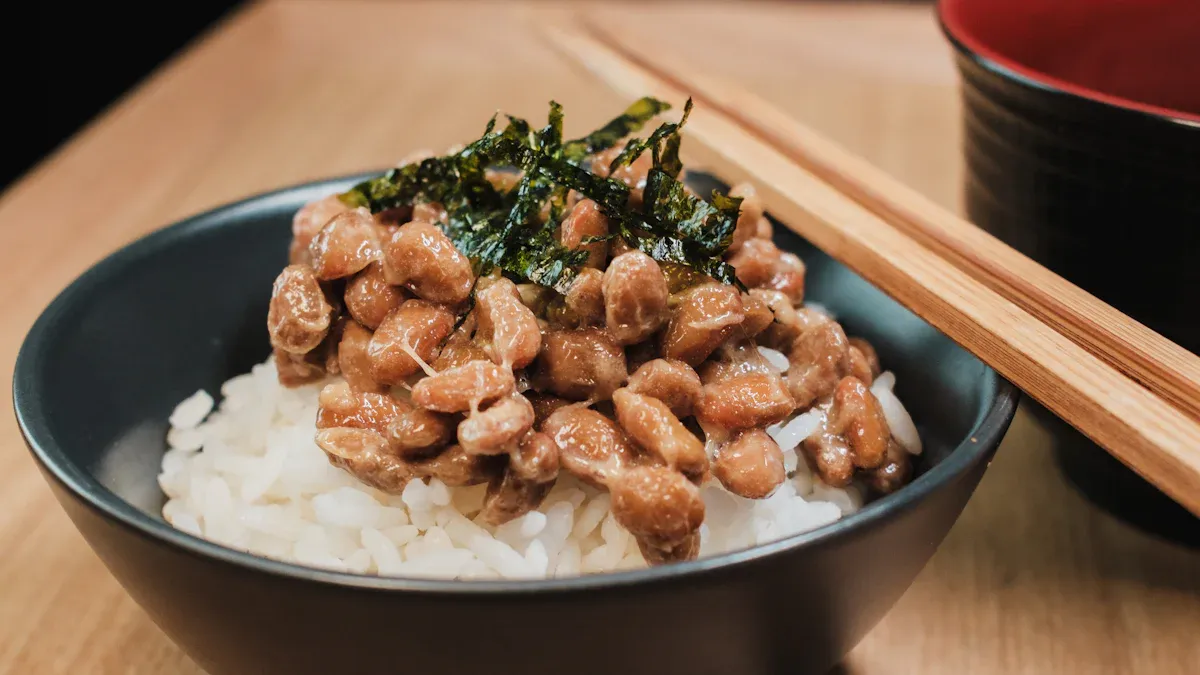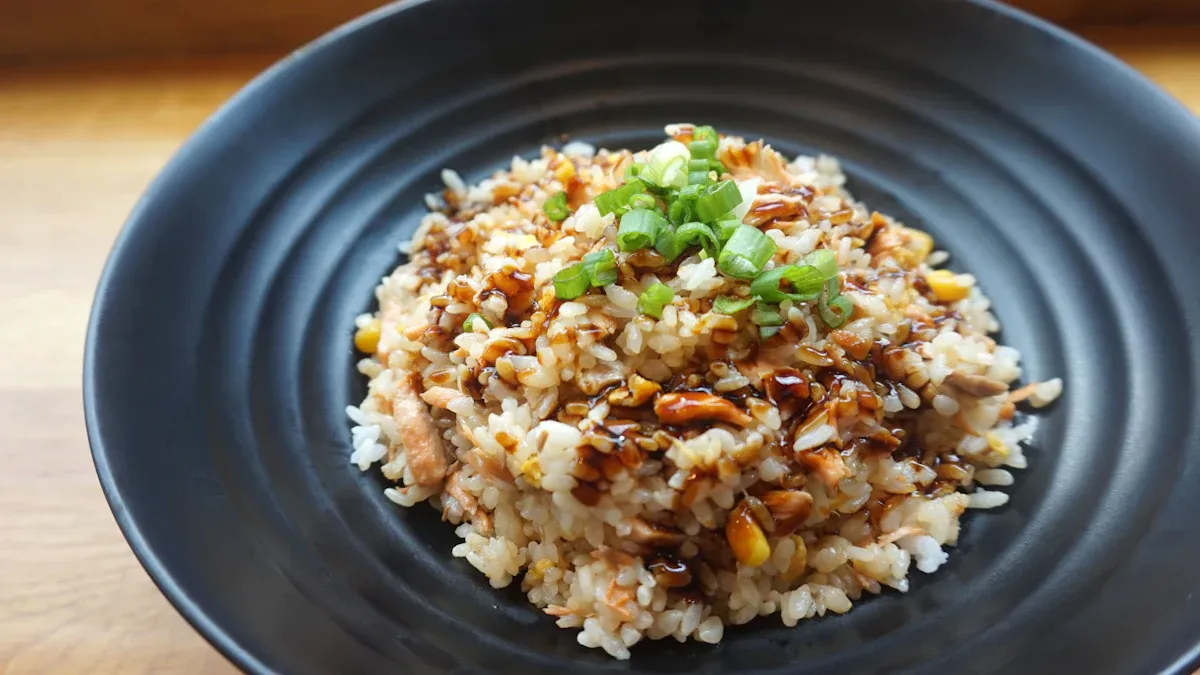Your Intro to Natto Breakfast Culture
Table of Contents

The natto breakfast bowl is a traditional Japanese meal of fermented soybeans served over rice. This fermented soybean dish often surprises newcomers with its sticky, stringy texture and pungent aroma. Exploring the natto breakfast culture reveals a rewarding culinary tradition dating back to the 1600s.
The simple breakfast provides significant health benefits. A serving of natto contains about 19 grams of protein and is one of the richest plant-based sources of Vitamin K2, a nutrient vital for bone health. Its probiotics also support a healthy digestive system.
Understanding the Natto Breakfast Culture
The natto breakfast culture is built on two core components: the fermented soybeans themselves and the perfect bowl of rice. Understanding these elements is the first step to appreciating this unique meal. People create natto through a specific fermentation process. This process gives the soybeans their famous sticky texture and strong, savory flavor.
What is Natto?
Natto is a traditional food made from soybeans. Producers ferment the beans with a beneficial bacteria called Bacillus subtilis. This fermentation creates the stringy texture and pungent aroma that natto is known for. Modern commercial natto packs usually come with two small packets. One contains tare, a soy-based sauce, and the other holds karashi, a spicy Japanese mustard.
There are several types of natto, mainly differing by the size of the soybean.
| Size of Soybeans | Name of Natto |
|---|---|
| Small | Ko-Tsubu Natto (小粒納豆) |
| Crushed | Hikiwari Natto (ひきわり納豆) |
| Large | O-Tsubu Natto (大粒納豆) |
Did you know? 🧐 While famous as a breakfast food, natto is not limited to the morning. A 2019 survey showed nearly 70% of Japanese respondents eat natto for dinner.
The Rice Foundation
The foundation of the natto breakfast is a bowl of fresh, hot, steamed rice. Japanese short-grain rice is the ideal choice. Its sticky texture and warmth are essential. The heat from the rice helps to release the aromas of the natto and slightly melts its sticky strings, creating a more unified and delicious dish. The simple natto breakfast culture has many regional variations across Japan. Different areas add unique ingredients to their natto and rice bowls.
| Region | Common Preparation Method |
|---|---|
| Hokkaido | Add sugar for a sweet and savory flavor |
| Fukushima | Mix with pickled Chinese cabbage (hakusai-zuke) |
| Western Japan | Often served with chopped okra |
These regional twists show the amazing adaptability of the natto breakfast culture.
Building Your Natto Breakfast Bowl

Creating a delicious natto breakfast bowl is a simple process. The key to a great experience lies in the preparation method. Following these steps helps unlock the best flavor and texture from the fermented soybeans.
Step 1: Whip the Natto
The first and most crucial step is to whip the natto. A person should open the container and stir the beans vigorously before adding any sauces. This step is essential for developing the ideal taste and texture.
For the best results, one should stir the beans about 50 times. This process typically takes one to two minutes. The goal is to transform the beans into a creamy, airy, and viscous mixture. The natto will become whiter and frothier as it is whipped.
Step 2: Add Seasonings
After whipping the natto, it is time to add the seasonings. Commercial natto packs include a soy-based tare sauce and a small packet of karashi mustard. A person adds these packets to the whipped beans and mixes everything together again. The mustard can enhance the savory flavor, but its use is optional.
Some people prefer to make their own sauce for a custom flavor profile. Here are two simple homemade tare recipes:
Step 3: Assemble the Bowl
The final step is assembling the breakfast. A perfect bowl of hot, steamed rice serves as the foundation. For a beautiful presentation, one can pack the cooked rice into a small bowl. Then, invert it onto a larger serving bowl to create a neat dome shape. This dome makes it easy to create a small indent in the center for toppings like an egg yolk.
Finally, pour the seasoned natto mixture over the hot rice. The heat from the rice will gently warm the natto, enhancing its aroma and creating a perfectly unified dish. Your classic natto breakfast bowl is now ready to enjoy.
Customizing Your Natto Experience

The classic natto bowl is a fantastic starting point. A person can easily customize it to suit their taste. Experimenting with different toppings and mix-ins is a key part of enjoying this versatile food. The journey from a simple bowl to a personalized creation is part of the fun.
Classic Toppings
Many people in Japan add simple toppings to their natto. These additions enhance the flavor and texture without overpowering the main ingredient. They are a great way for beginners to start personalizing their meal.
A raw egg yolk is a very popular choice. It adds a rich, creamy texture that balances the stickiness of the natto. The combination of raw egg, natto, and hot rice is a beloved comfort food known as tamago kake gohan with a twist.
Here are some of the most common classic toppings:
- Chopped scallions or green onions (negi)
- A raw egg yolk placed in the center
- Shredded seaweed (kizami nori)
- A small dash of extra soy sauce
Flavorful Mix-ins
For those seeking more complex flavors, a wide variety of mix-ins can transform the dish. These ingredients introduce new dimensions of taste, from spicy and sour to fresh and herbaceous.
Shiso leaves are an excellent choice for adding a fresh, bright note. The leaves contain an essential oil called perillaldehyde, which gives them a refreshing aroma. This unique flavor cuts through the richness of the natto and enhances each bite. Other popular mix-ins offer different taste profiles.
| Mix-in | Flavor Profile |
|---|---|
| Kimchi | Adds a spicy, sour, and crunchy element. |
| Katsuobushi | Provides a smoky and savory umami flavor. |
| Umeboshi Paste | Introduces a distinct salty and sour taste. |
| Grated Yamaimo | Creates an extra slimy, smooth texture. |
Beyond the Rice Bowl
Natto is not limited to a bowl of rice. Its unique properties make it a great ingredient in other dishes. People enjoy it with noodles, on toast, and even in omelets. This adaptability makes it a staple in many Japanese kitchens beyond the morning breakfast.
One popular alternative is Natto Soba. This dish often features cold soba noodles topped with natto and other fresh ingredients. A simple sauce ties everything together.
- Sauce: A person can make a sauce by combining vinegar, soy sauce, sesame oil, sugar, and cold water.
- Toppings: Common additions include julienned cucumber, chopped pickled daikon radish (takuan), and deep-fried bean curd (atsuage).
Another creative option is Natto Toast, often made with fluffy Japanese milk bread (shokupan). A person can make a simple version with egg salad.
- First, prepare an egg salad by mashing hardboiled eggs with mayonnaise.
- Spread the egg salad evenly on a slice of bread.
- Next, whip the natto with its included sauce and mustard packets.
- Spread the prepared natto mixture over the egg salad.
- Finally, toast the bread until it is golden brown.
The natto breakfast bowl is a simple and highly nutritious part of the natto breakfast culture. A person can prepare this meal in just a few minutes. People should feel adventurous and experiment with different pairings. Trying mix-ins like kimchi, avocado, or even cheese can help a person find a combination they love.
Why not try making your own unique breakfast this week? You can discover a new Japanese tradition and a delicious meal. 🥢
FAQ
Where can a person buy natto?
A person can find natto in the refrigerated section of most Asian grocery stores. Japanese markets often carry a wider variety of brands and bean sizes. The natto is typically sold in small, individual styrofoam packs, making it easy to try.
How can someone reduce the strong smell?
Whipping the natto vigorously before adding sauce helps lessen its pungent aroma. A person can also add flavorful toppings to balance the scent.
Try This! 💡 Mix-ins like chopped scallions, kimchi, or a raw egg yolk are excellent for mellowing the natto’s strong character and adding delicious complexity.
Is natto a healthy food?
Yes, natto is a highly nutritious food. It provides significant plant-based protein and beneficial probiotics that support gut health. Natto is also one of the richest food sources of Vitamin K2, a nutrient essential for maintaining strong bones.
Can a person eat natto every day?
Many people in Japan eat natto daily as part of a balanced diet. Its rich nutritional profile makes it a healthy choice for regular consumption. As with any food, it fits best within a varied and mindful eating plan.

Poseidon
Master of Nutritional Epidemiology, University of Copenhagen, Herbal Functional Nutrition Researcher
Focus: The scientific application of natural active ingredients such as Tongo Ali, Horny Goat Weed, and Maca to sexual health and metabolic regulation.
Core Focus:
Men: Use a combination of Tongo Ali (an energizing factor) + Maca (an energy reserve) to improve low energy and fluctuating libido.
Women: Use a combination of Horny Goat Weed (a gentle regulator) + Maca (a nutritional synergist) to alleviate low libido and hormonal imbalances.
Stressed/Middle-Aged Adults: This triple-ingredient synergy supports metabolism, physical strength, and intimacy.
Product Concept:
Based on traditional applications and modern research (e.g., Tongo Ali promotes testosterone-enhancing enzyme activity, and icariin provides gentle regulation), we preserve core active ingredients and eschew conceptual packaging—using natural ingredients to address specific needs.
Simply put: I'm a nutritionist who understands "herbal actives." I use scientifically proven ingredients like Tongo Ali, Epimedium, and Maca to help you make "sexual health" and "nutritional support" a daily routine.
